Aircraft and climate¶
(Almost) all aircraft burn fossil fuels, producing CO2, which has a warms the climate [1]. This aviation CO2 is responsible for about 2% of the total human forcing of the climate.
CO2 emissions from many sectors are decreasing, but air travel is still growing, so aviation will contribute more to future climate change, resulting in almost 0.1 degrees of warming from aviation alone by 2050. Aviation has a reputation as a 'hard to decarbonise' sector - while fossil-fuel replacements for aviation are in development, reaching net zero by 2050 will be ... challenging.
This is not to say that there is no hope - aircraft fuel efficiency has been improving at around 1% per year, which really adds up over 50 years! If CO2 emissions are the only thing you care about, flying on newer aircraft can be significantly better for the climate [2]! Unfortunately, CO2 is not the only impact aircraft have on climate.
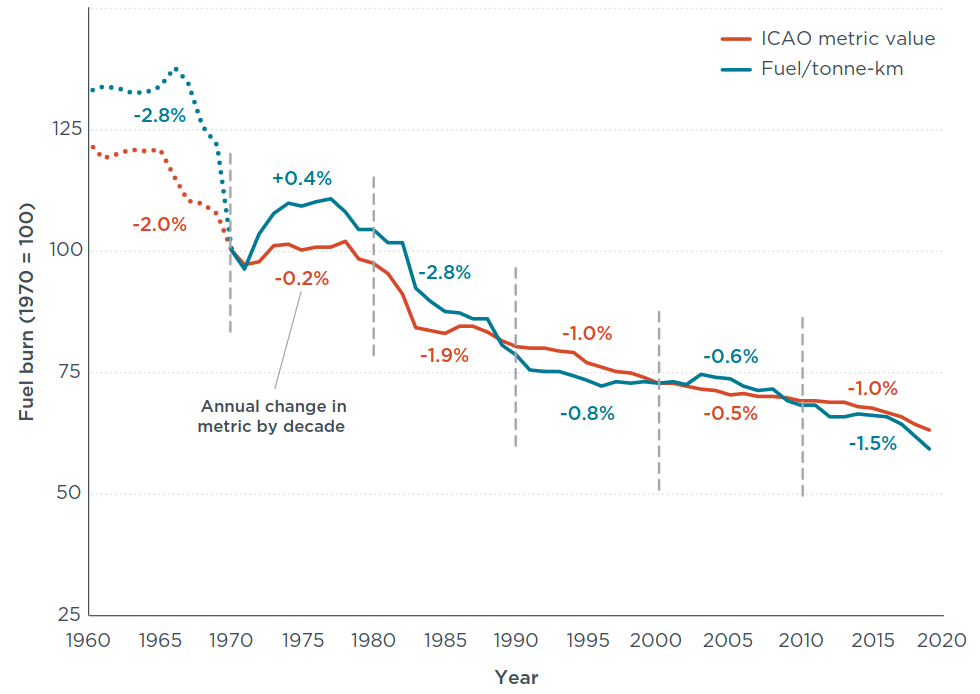
The average fuel burn of new commercial aircraft (Zheng and Rutherford, ICCT, 2020)
The role of clouds¶
When they burn jet fuel, aircraft emit water, heat and soot as byproducts. If the conditions in the atmosphere are right, this extra water can form clouds, known as contrails. As these clouds are high in the atmosphere, they are much colder than the surface [3].
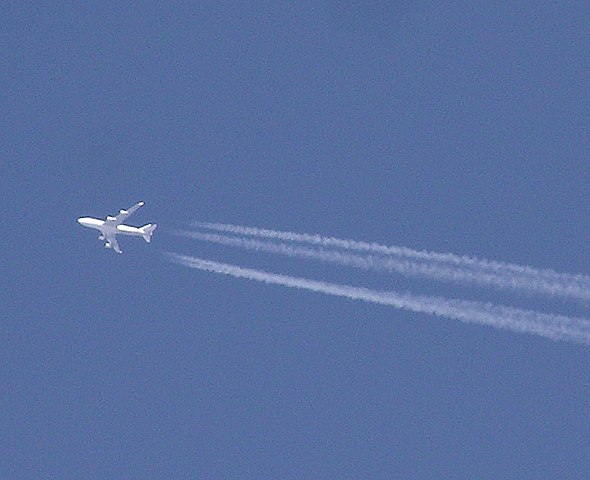
This aircraft is at and altitude of approximately 10km, where the temperature is often as low as -60C (Wikimedia user Arpingstone)
A cold object emits less infra-red energy than a warm object - so a cold cloud overlying a warm surface means the Earth emits less energy to space, effectively trapping heat in the atmosphere. While contrails also reflect sunlight (giving them a cooling effect), their heating effect wins out. On average, contrails warm the Earth.
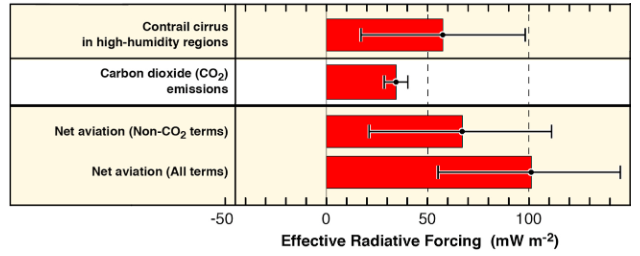
The relative impact of aviation CO2 and contrails, measured through the 'effective radiative forcing'. There are some other aviation impacts not shown in detail here - you can see the full plot (and also why it is not reproduced completely) in Lee et al, Atmos. Env. (2021).
The exact size of the contrail warming effect is uncertain, but it is thought to be a bit larger than the CO2 forcing, more than doubling the climate impact of aviation.
Not all aircraft are created equal when forming contrails though. Contrail formation depends strongly on the properties of the air an airplane flies in. It is also possible that different aircraft create contrails of with different properties, particularly if they emit different amounts of soot.
Aircraft soot¶
The idea that variations in aircraft exhaust might create contrails with different properties is not new [4]. The ice particles in contrails form on the soot particles in the aircraft exhaust. More soot particle means more (but smaller) ice crystals, that sediment into drier air less quickly and so could mean the contrail lives for longer.
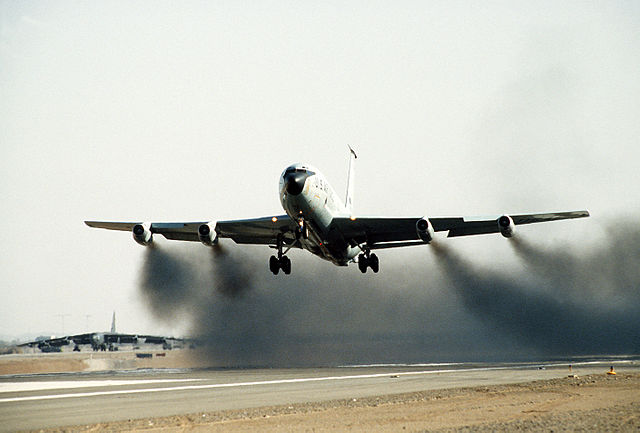
This older 707-family aircraft emits a lot of soot! Most newer aircraft are much, much cleaner than this. (USAF)
Models are quite clear about this effect, but it has been harder to observe in practice. Chase aircraft can measure contrails within 10-15 min of them forming and generally find more crystals inside contrails formed from more polluting aircraft [5]. However, the longest-lived contrails are most important for the climate and these are very difficult to match to the generating aircraft when you are flying through them yourself.

Who is responsible for this contrail? It is not a simple question to answer
Even worse, it is not clear how well this simple theoretical argument works beyond about 10-15 min after contrail formation. We know that the number of crystals in a contrail will decrease quicker over time if the contrail starts out with a lot of crystals. This might wipe out the difference in ice crystal number (and size) between contrails from different aircraft [10].
To determine if more polluting aircraft really do form longer-lived contrails, we need to track the contrails over their lifetime - the best tool for this is satellites.
Tracking contrails¶
It turns out that contrails have a couple of properties that make them easy to identify in satellite imagery. First, they are composed of lots of small ice crystals, which means they stand out in infra-red imagery. Second - they are typically straight (although not always) and there are relatively few straight lines in the atmosphere other than contrails.
These properties make they a good target for identifying with a neural network!
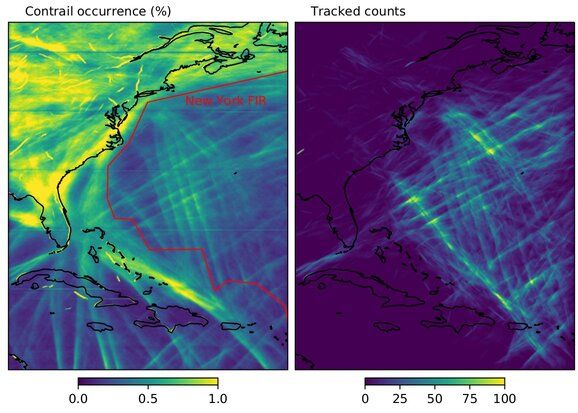
The location of all the contrail-like things found by the neural network (left) and the objects that were confidently matched to aircraft (right). The red line is the edge of the New York flight information region, where the air traffic data is better and more complete.
Unfortunately a few other things (like rivers) also look like contrails to the neural network - you can see them popping up on the map on the left. However, rivers typically don't form just after an aircraft has gone past and they don't move with the aircraft-altitude winds. We can use these to do some extra filtering and then match the 'contrail objects' to aircraft flight data.
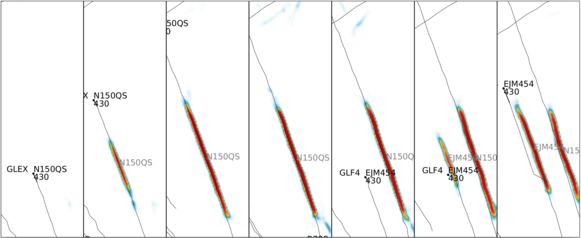
Tracking contrails from individual aircraft. Each image is separated by 10 minutes, but we can attribute the contrails to aircraft using information about the aircraft-level winds to estimate where a contrail would have formed.
We can then measure how long each bit of the contrail lives for. Using this large library (>64,000 cases) of tracked contrails from specific aircraft, we can now start to check the theory to see if it works in practice!
Even though we didn't previously have much observational evidence, there is pretty good theoretical evidence that more polluting aircraft should produce longer-lived contrails. That made this graph a bit of a surprise
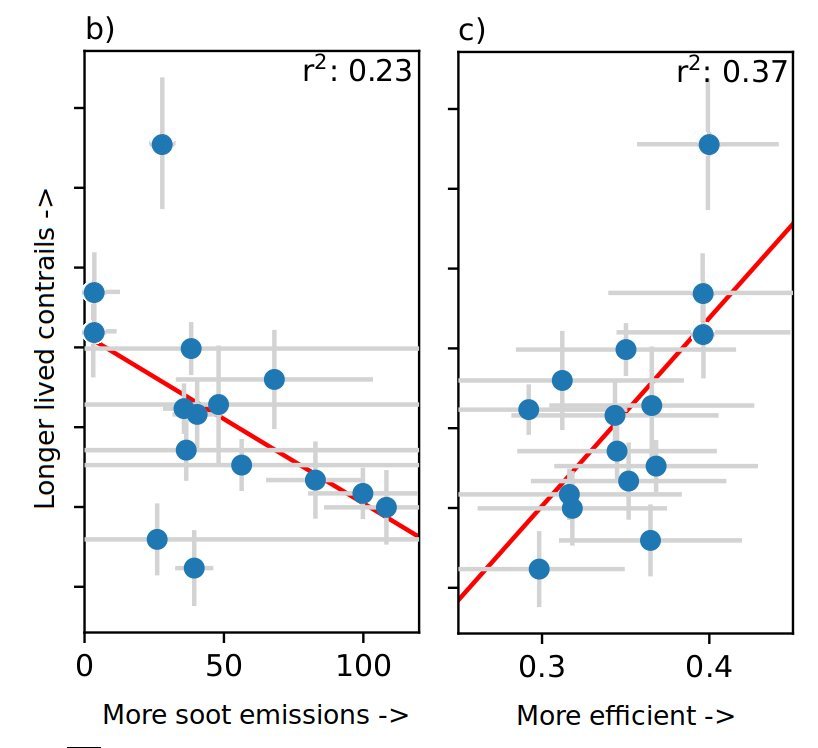
Contrail lifetimes apparently get longer as aircraft get more fuel efficient and produce less soot particulate pollution!
The impact of efficiency¶
Our data here is pretty clear - more efficient aircraft (typically newer aircraft) form longer-lived contrails. These aircraft also usually have lower soot emissions in the aircraft exhaust. Low soot aircraft forming longer-lived contrails is the exact opposite of what we expected!
It turns out that soot is not the only thing that differs between these aircraft. Modern aircraft also fly higher than older aircraft to achieve their higher efficiencies [6]. This means that when they form a contrail, it will typically be much colder, often several degrees below the contrail formation threshold temperature.
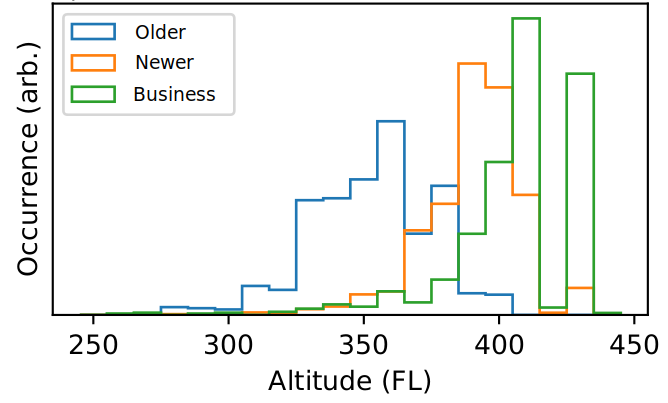
The distribution of contrail altitudes for three different types of plane. The older aircraft form contrails lower in the atmosphere, where it is warmer. Altitude is in flight levels (FL = 100ft)
So modern aircraft create colder contrails (or at least, much colder than the threshold temperature) - how does this connect to them living longer?
One possibility is how the ice crystals form behind the aircraft. The ice crystals form on the soot particles in the exhaust, but not all soot particles are created equal. Some soot particles are better at forming ice crystals than others [7], meaning that they can form an ice crystal for a contrail closer to the threshold temperature.
A colder contrail then has more of the soot particles forming ice crystals. So if you take the same type of aircraft, with the same soot emissions, but form a colder contrail, you would expect that contrail to have more ice crystals. As these crystals are smaller on average, they sediment less quickly and so the contrail can live longer.

The aircraft flying close to the threshold temperature (top) produces fewer, larger crystals when compared to the aircraft producing colder contrails, even though they have the same soot emissions.
So overall - more efficient aircraft fly higher, creating colder contrails with more, but smaller ice crystals in them, so that they live longer [8]. The important part of this explanation is that it is not the aircraft design making it worse for the climate, but rather how the airplane is used.
Impact of soot¶
But what happened to the impact of varying soot emissions? It turns out that this is very difficult to spot, as the impact of changing flight altitude dominates. However, you can see some hints of it when looking at specific aircraft types.
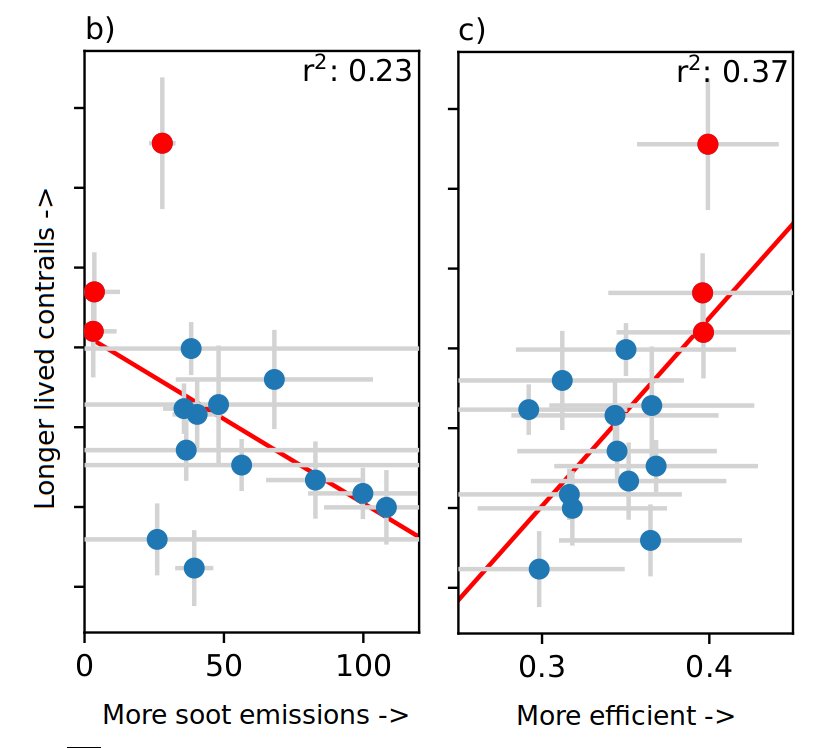
This plot again! But it has red dots! These are all from the same aircraft type, so have similar flight patterns and altitudes. In this case, more soot produces longer-lived contrails!
These dots are all a single type of aircraft, but with different engine designs with different soot emission rates. For this single type (admittedly only three points), you see a hint of the impact of soot controls. If you reduce the soot emitted by your aircraft, not only do you improve air quality, but you might make your contrails shorter lived (and so have a climate benefit too [9]).
This is really exciting! It had been predicted by models, but there was no observational evidence that reducing aircraft soot emissions would impact contrail lifetime in this way. It turns out that it is very difficult to pick out (as contrails are very complex), but there is encouraging evidence of soot reductions as a pathway to reduce the climate impact of aviation.

Not enough to declare victory over contrails yet, but a necessary step
Small aircraft, large climate impact?¶
While they are a small component of the overall aviation climate impact, private or business aircraft receive a lot of the publicity. They only carry a small number of passengers (usually less than 10 and sometimes none at all), but as they are small, they also use less fuel [11]. As they use less fuel, it was thought that they might also produce fewer contrails.
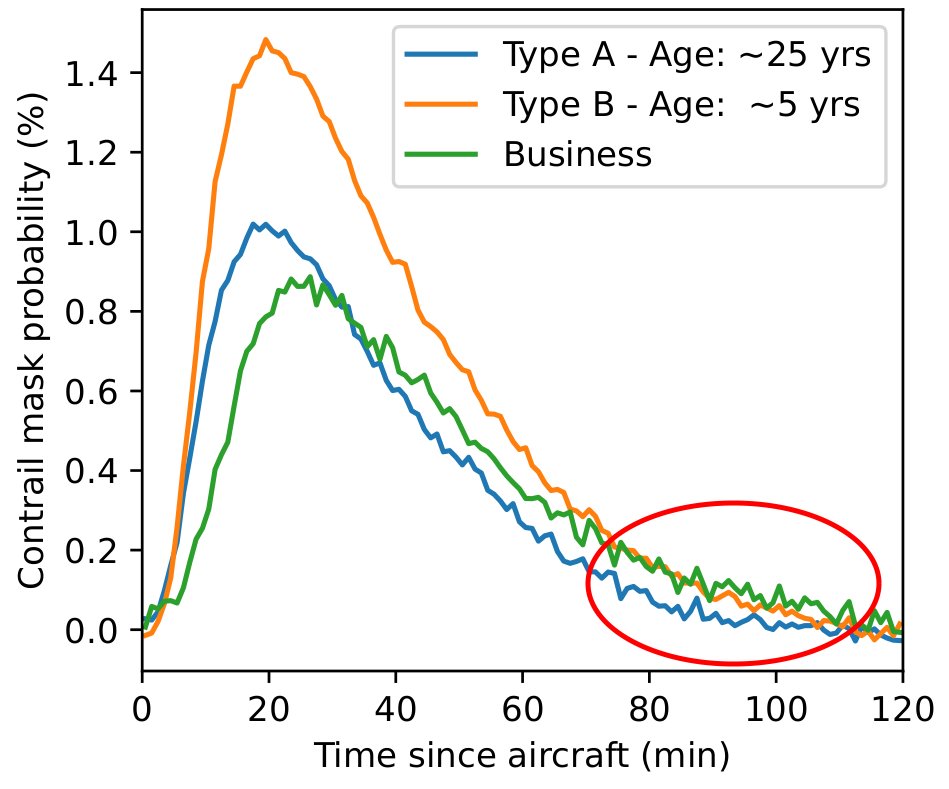
Business aircraft/private jets form long-lived contrails that have similar occurrences and lifetimes to much larger aircraft (Type A and Type B here are large commercial jet each carrying more than 200 passengers).
It turns out that the small fuel usage does not translate into a small climate impact through contrails. On the contrary, private jets/business aircraft produce contrails as if they were a large commercial jet!
Again, we don't have enough data to be sure as to why, but the reason is likely linked to temperature and soot. With their very light loads, business jets typically fly very high, above other aircraft. This givens them more freedom for routing, but also means that the contrails formed can be even colder!
These exceptionally cold contrails could lead to a very high fraction of the soot becoming ice crystals in the contrail, creating contrails with lots of small ice crystals that live for a long time. To be sure of what is happening, we need to make new measurements of these private jet aircraft to understand why they appear so often and to measure their impact on the climate [12].
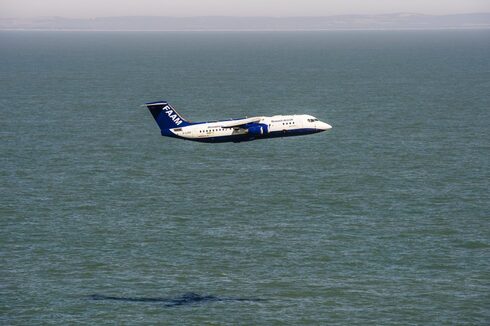
Small jet aircraft are sometimes necessary. This is the UK atmospheric research aircraft (FAAM) flying very low over the ocean, something you definitely wouldn't want to do in a 787! (via NERC)
This article is based the research paper 'Operational differences lead to longer lifetimes of satellite detectable contrails from more fuel efficient aircraft', which is available to read for free. Thanks to Marc Stettler, Roger Teoh and Oliver Driver (Imperial College London), Ulrike Burkhardt and Toni Delovski (DLR) and David Painemal (NASA Langley Research Center/Analytical Mechanics Associates Inc.), who worked with me on this research.
Comments by email
Notes¶
| [1] | Battery power might be a solution for some aircraft, hopefully in the near future! |
| [2] | Aircraft use a lot more fuel for takeoff and landing, so all else being equal, a longer direct flight would use less fuel that one with multiple layovers. The increased range on the newes aircraft (such as the 787) helps with this a bit. |
| [3] | The atmosphere generally gets colder as you go higher up (as you might have experienced going up a mountain). At aircraft cruising altitudes, it might be 60-70C below zero. |
| [4] | There are some techniques proposed back in the 1960s and 70s for reducing contrail formation by introducing extra particles into the exhaust to increase the number and decrease the size of the ice crystals until they become invisible. This produces some spectacular images and may be important for military applications, but it is not clear whether this is appropriate to reducing the climate impact of aviation - it may be exactly the wrong thing to do! |
| [5] | While there are some comparisons between different aircraft types, this is usually a comparison between the same aircraft burning different fuel (such as the ECLIF series of trials) |
| [6] | These aircraft often fly with very high bypass engines (meaning that they have a much colder exhaust). There is a broad trend in aircraft engines increasing over time (video from MinutePhysics) |
| [7] | Actually, for the initial stages of the contrail (when it is less than a second old), it is made up of droplets of liquid water, rather than ice crystals. This means that technically, we care about how good the soot particle is at forming a liquid water droplet. |
| [8] | I need to add at this point that as we don't have any measurements of the ice crystal number, we don't know for sure that this is what is happening. At Imperial, together colleagues at the University of Leeds, we are making new measurements later this year to answer this question! More details to come. |
| [9] | Co-benefits of climate action make the world a nicer place to live in, even if we weren't trying to avoid dangerous climate change |
| [10] | There was actually some theoretical studies that suggest that if you reduce soot enough, you start forming ice crystals on other things in the engine exhaust. This would mean that very clean aircraft produce lots of ice crystals (which might then live for a much longer time). It doesn't seem like we are at that stage yet though (luckily) and there hasn't yet been any observations of this effect in the field. |
| [11] | This makes them about 10 times as polluting per passenger mile as a commercial jet (report). |
| [12] | Although frankly, their CO2 emissions alone are damaging enough. In just one year, a single private jet can cause multiple lifetimes of climate damage compared to the average person.. |